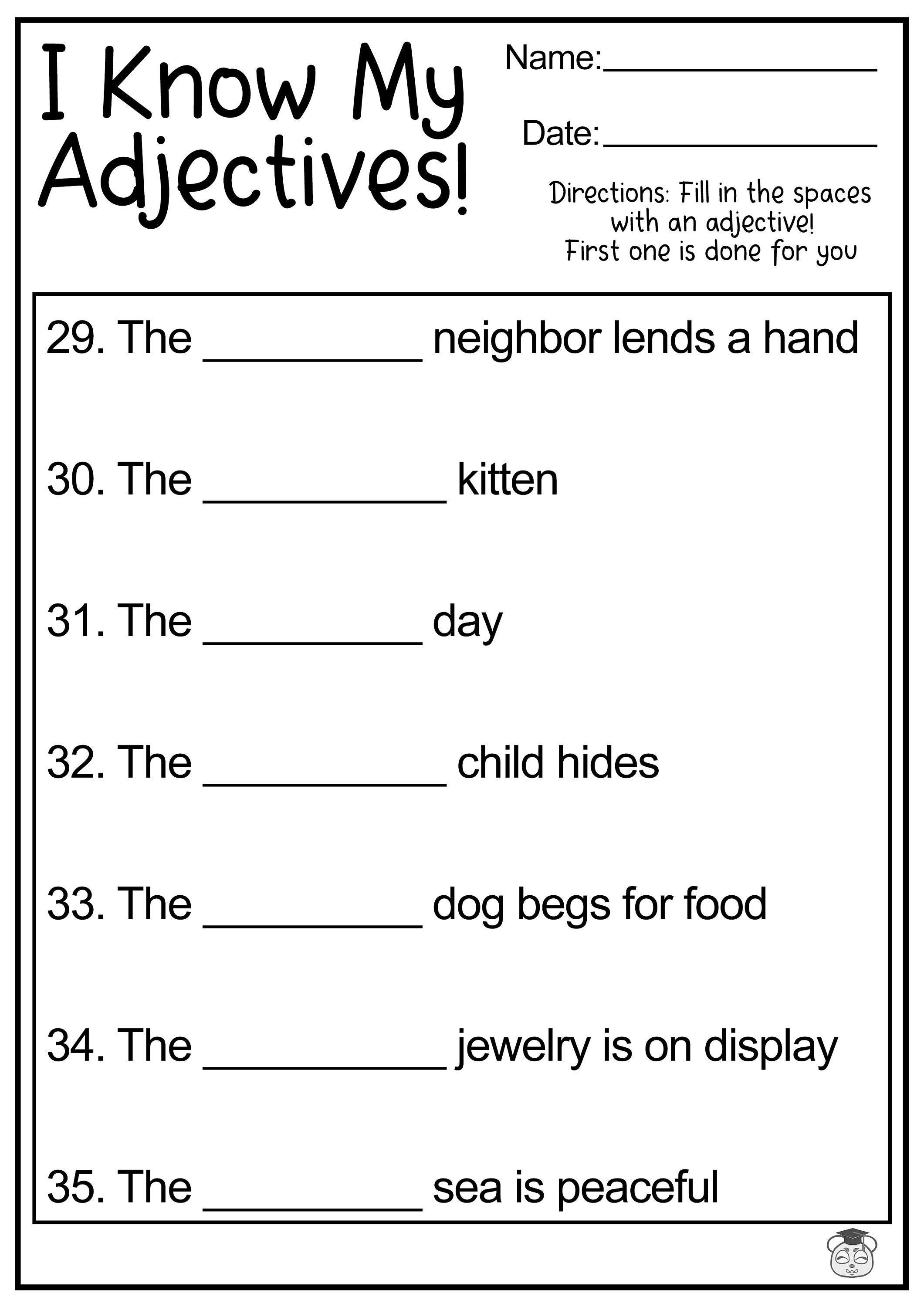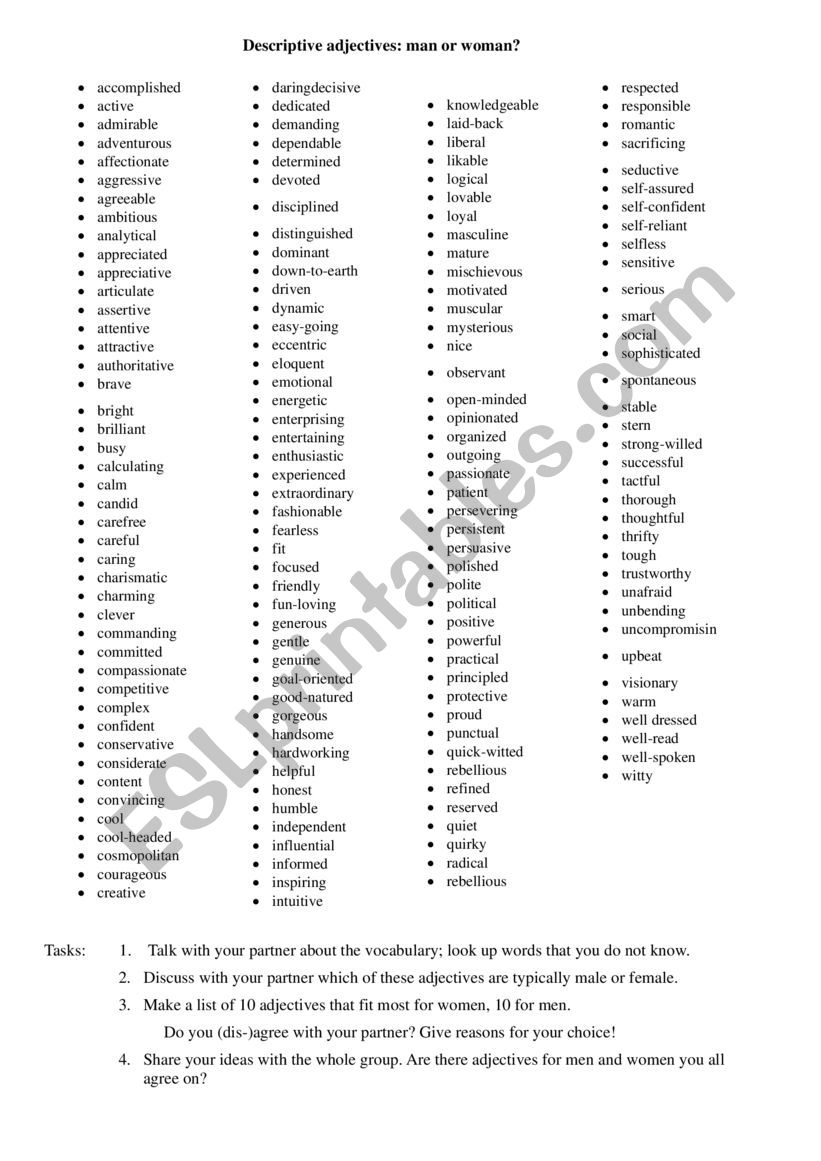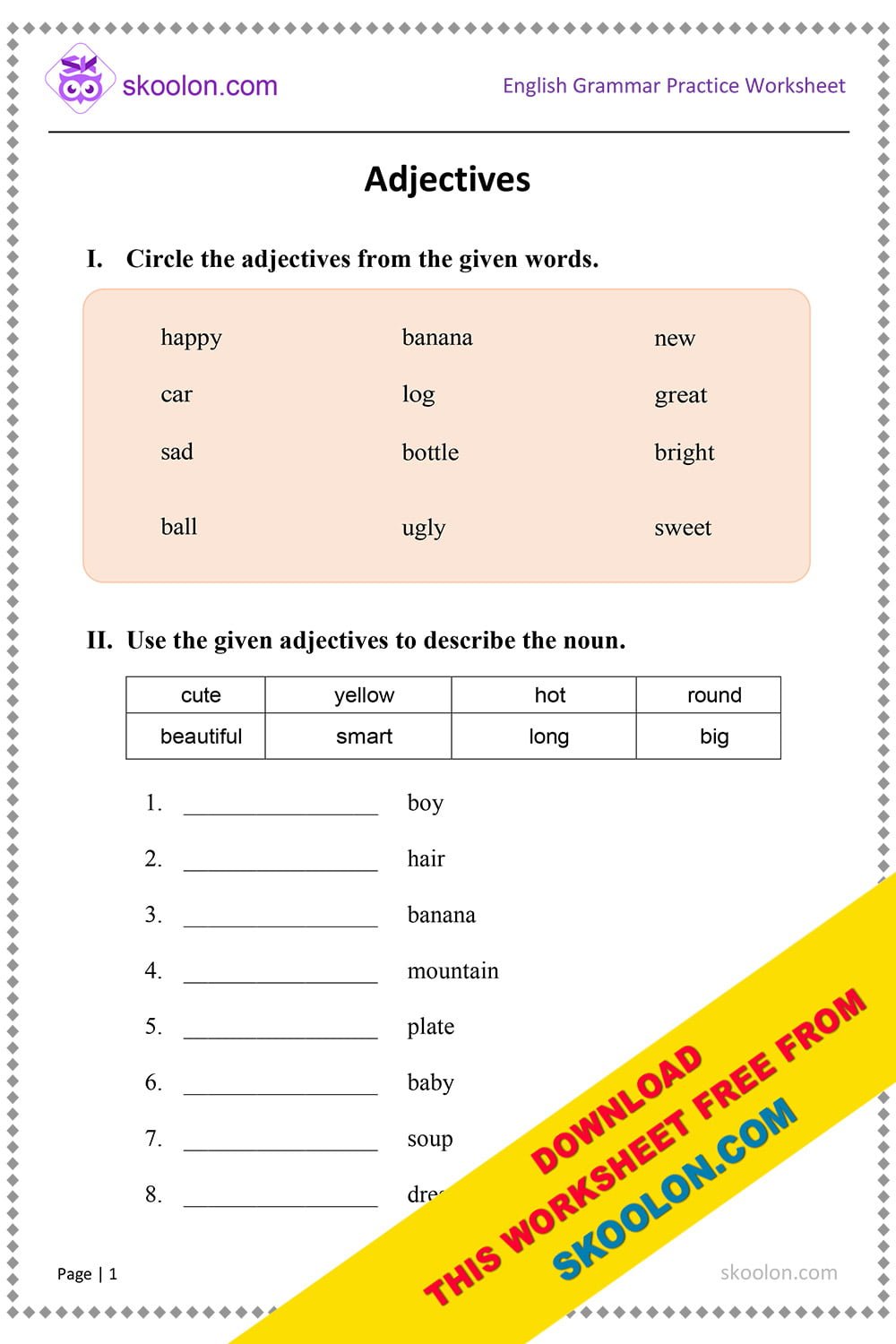
Unlocking Linguistic Potential: The Transformative Power of Adjective Partner Work Worksheets
In the dynamic landscape of language education, fostering a deep understanding of grammatical concepts is paramount. Among the various parts of speech, adjectives play a crucial role in enriching descriptions, adding nuance, and making language vibrant. However, teaching adjectives can often feel repetitive, relying heavily on rote memorization or isolated exercises. This is where the innovative approach of adjective partner work worksheets comes into its own, offering a collaborative, engaging, and highly effective method for students to master this essential linguistic component.
This comprehensive article will delve into the multifaceted benefits, practical design considerations, diverse activity types, and successful implementation strategies for leveraging adjective partner work worksheets in any educational setting. We will explore how these collaborative tools not only solidify grammatical understanding but also enhance critical thinking, communication skills, and overall classroom dynamics.

The Power of Collaboration in Language Acquisition

Before diving into the specifics of adjective worksheets, it’s vital to understand the pedagogical foundation that makes partner work so effective. Collaborative learning, rooted in constructivist theories, posits that knowledge is not passively received but actively constructed through social interaction. When students work in pairs, they:

- Engage Actively: Passive listening is replaced by active participation, discussion, and problem-solving.
- Receive Immediate Feedback: Peers can offer instant corrections or affirmations, which is often more impactful than waiting for teacher feedback.
- Articulate Understanding: Explaining concepts to a partner solidifies one’s own understanding and reveals gaps in knowledge.
- Reduce Anxiety: Working with a peer can be less intimidating than performing individually, encouraging participation from quieter students.
- Develop Communication Skills: Students learn to negotiate meaning, listen actively, and express ideas clearly.



These inherent advantages of partner work make it an ideal format for tackling grammar concepts like adjectives, which require both conceptual understanding and practical application.
Understanding Adjectives: The Building Blocks of Description

Adjectives are words that describe or modify nouns and pronouns, providing more information about their qualities, quantities, or states. They answer questions like "What kind?", "How many?", or "Which one?". Mastering adjectives allows students to:
- Create vivid imagery in their writing and speaking.
- Distinguish between similar items or ideas.
- Convey precise meanings.
- Enhance their vocabulary and expressive range.


Given their descriptive power, adjectives lend themselves perfectly to activities that encourage creative application and nuanced understanding, which is precisely what adjective partner work worksheets are designed to do.
Designing Effective Adjective Partner Work Worksheets
The success of any collaborative activity hinges on the quality of its design. Effective adjective partner work worksheets are meticulously crafted to maximize learning outcomes and foster productive interaction. Key design elements include:
- Clear and Concise Instructions: Students should know exactly what they need to do, how to do it, and what the expected outcome is. Using bullet points, bold text, and simple language is crucial.
- Varied Activity Types: Repetition can lead to boredom. Incorporate a mix of activities that cater to different learning styles and engage various cognitive processes.
- Scaffolding: Start with simpler tasks and gradually increase complexity. Provide examples or sentence starters for struggling learners.
- Defined Roles (Optional but Recommended): Assigning roles (e.g., "Reader," "Writer," "Checker," "Timekeeper") ensures equal participation and accountability.
- Built-in Self-Correction/Answer Keys: For some activities, providing an answer key allows partners to check their work immediately, promoting independence and immediate feedback.
- Real-World Context: Connect adjective usage to authentic situations, making the learning relevant and transferable.
- Visually Appealing Layout: Use clear fonts, appropriate spacing, and relevant images or graphics to make the worksheet inviting and easy to navigate.
Varieties of Activities for Adjective Partner Work Worksheets
The versatility of adjectives allows for a wide array of engaging activities within partner work settings. Here are some examples that can be incorporated into adjective partner work worksheets:
- Adjective Matching/Categorization:
- Match adjectives to their antonyms or synonyms.
- Categorize adjectives by type (e.g., color, size, emotion, opinion).
- Match adjectives to specific nouns they might describe (e.g., "fluffy" with "cloud," "brave" with "knight").
- Sentence Expansion/Creation:
- Provide a simple sentence (e.g., "The dog barked.") and have partners add two or three adjectives to describe the noun (e.g., "The tiny, fluffy dog barked loudly.").
- Give a list of nouns and have partners create descriptive sentences using a specified number of adjectives for each.
- Challenge partners to create sentences using comparative or superlative adjectives (e.g., "My car is faster than yours," "This is the most beautiful flower.").
- Descriptive Writing Challenges:
- Picture Description: Provide an interesting image and have partners brainstorm and list as many adjectives as possible to describe elements within the picture. Then, they can write a short paragraph using those adjectives.
- "Describe the Room" Scavenger Hunt: Partners identify objects in the classroom and write down adjectives to describe them (e.g., "The wooden desk," "The bright window").
- Character/Place Description: Give a basic character or place prompt and have partners collaboratively build a detailed description using a rich vocabulary of adjectives.
- Adjective Story Starters:
- Provide the first sentence of a story that uses an adjective (e.g., "The mysterious box sat on the table."). Partners then continue the story, ensuring they incorporate new adjectives into each subsequent sentence.
- "Guess the Adjective" Games:
- One partner thinks of an object and describes it using only adjectives. The other partner guesses the object. Roles then switch. This can be structured on a worksheet with spaces for "Adjectives Used" and "Guessed Object."
- Adjective Charades/Pictionary:
- Write adjectives on cards. One partner acts out or draws the adjective, and the other guesses. This adds a kinesthetic and visual element.
- Opinion Adjective Debates:
- Present two contrasting items (e.g., "Dogs vs. Cats," "Summer vs. Winter"). Partners brainstorm opinion adjectives to support their preference and then verbally "debate" or write a short persuasive paragraph.
Pedagogical Benefits of Adjective Partner Work Worksheets
The implementation of adjective partner work worksheets yields a multitude of benefits for both students and teachers:
- Enhanced Engagement: The interactive nature of partner work keeps students motivated and actively involved in the learning process.
- Immediate and Peer-Based Feedback: Students receive constructive feedback from their peers in real-time, allowing for immediate correction of misconceptions.
- Deeper Conceptual Understanding: By discussing, explaining, and applying adjectives, students move beyond superficial memorization to a more profound grasp of their function and usage.
- Improved Communication Skills: Students develop their ability to articulate ideas, listen actively, negotiate, and collaborate effectively.
- Critical Thinking and Problem-Solving: Many activities require students to analyze, synthesize, and make choices about the most appropriate adjectives for a given context.
- Increased Confidence: Success in a collaborative setting builds self-esteem, especially for students who might be hesitant to participate individually.
- Reduced Teacher Workload (for formative assessment): While teachers still monitor, much of the immediate feedback loop is handled by the students themselves, freeing up the teacher to observe, intervene strategically, and conduct more in-depth assessments later.
- Differentiated Instruction: Worksheets can be easily adapted to meet the needs of diverse learners, offering scaffolding for struggling students and advanced challenges for high achievers.
Practical Implementation Strategies
To maximize the effectiveness of adjective partner work worksheets, consider these practical strategies:
- Strategic Grouping: Decide whether to group students homogeneously (similar ability) or heterogeneously (mixed ability). Heterogeneous grouping often allows stronger students to mentor weaker ones, while homogeneous grouping can facilitate targeted instruction.
- Clear Expectations and Modeling: Before starting, clearly explain the activity, the roles (if assigned), and the expected noise level. Model how to complete a portion of the worksheet.
- Monitoring and Facilitating: Circulate among groups, listen to discussions, offer guidance, and address misconceptions. Avoid "rescuing" students too quickly; encourage them to problem-solve together first.
- Time Management: Set clear time limits for each activity or section. Use a timer to help students stay on track.
- Debriefing/Sharing: After the activity, bring the class back together to share examples, discuss challenges, and clarify any lingering questions. This reinforces learning and provides an opportunity for whole-class feedback.
- Accountability: Collect the completed worksheets. Even if they are self-checked, collecting them shows students that their effort is valued and provides a record of their work.
Addressing Common Challenges
While highly beneficial, partner work can present certain challenges. Proactive measures can mitigate these:
- Unequal Participation: Assign specific roles, use peer evaluation, or design tasks where both partners must contribute (e.g., Partner A writes first two sentences, Partner B writes next two).
- Off-Task Behavior: Ensure the activity is engaging and appropriately challenging. Clear expectations and frequent monitoring can help.
- Noise Levels: Establish a "working voice" expectation. Provide a clear signal for quiet attention.
- Misconceptions Persisting: While peer feedback is valuable, it’s not always perfect. The teacher’s role in monitoring and a whole-class debrief is crucial for correcting widespread errors.
Differentiation and Assessment
Adjective partner work worksheets are inherently flexible for differentiation:
- For struggling learners: Provide word banks of adjectives, sentence frames, or simplify the tasks.
- For advanced learners: Encourage the use of more sophisticated vocabulary, ask them to justify their adjective choices, or challenge them to write more complex descriptive passages.
Assessment can be integrated through:
- Observation: Teachers can note student understanding and collaboration skills as they circulate.
- Peer Assessment: Students can evaluate each other’s contributions based on a rubric.
- Quick Checks: Collect a few examples from each pair to gauge overall understanding.
- Exit Tickets: Ask students to individually write one sentence using an adjective correctly after the partner work.
Integrating Technology with Adjective Partner Work Worksheets
In the digital age, adjective partner work worksheets can transcend traditional paper formats:
- Google Docs/Microsoft Word Online: Students can collaboratively type and edit descriptions or sentences in real-time.
- Interactive Whiteboards/Jamboard: Partners can drag and drop adjectives, annotate images, or collaboratively build mind maps.
- Online Quiz Platforms: Some platforms allow for collaborative quiz creation or completion.
- Digital Storytelling Tools: Partners can use adjectives to create interactive stories or presentations.
Conclusion
Adjective partner work worksheets are far more than just exercises; they are dynamic learning tools that harness the power of collaboration to deepen grammatical understanding, foster critical thinking, and cultivate essential communication skills. By thoughtfully designing varied activities, setting clear expectations, and actively facilitating the learning process, educators can transform what might otherwise be a mundane grammar lesson into an engaging and highly effective linguistic exploration. Embracing these collaborative worksheets not only solidifies students’ grasp of adjectives but also empowers them to become more confident, articulate, and creative users of the English language.
